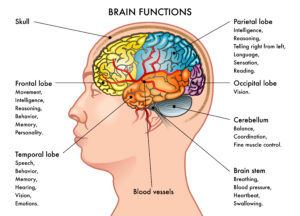Caring for Someone with Dementia: Importance of Understanding the Brain
Caring for someone with dementia can be challenging. Understanding what happens to the brain when someone develops dementia will help you manage day to day activities. Dementia affects many parts of the brain, not just parts involved in memory, but also language, movement, and behavior. Understanding that dementia involves more than a problem with memory is very important. Learning about the brain can help decrease the stress and confusion that may come from seeing your loved have difficulty with daily tasks or have behavior changes.
This image provides a list of all the many tasks our brain manages.
 Illustration 125548555 © Rob3000 | Dreamstime.com
Illustration 125548555 © Rob3000 | Dreamstime.com
The National Institute of Health provides a good introduction called The Geography of Thought. This narrative provides information on what each section of the brain does related to our everyday life.
The Geography of Thought
“Each cerebral hemisphere can be divided into sections, or lobes, each of which specializes in different functions. To understand each lobe and its specialty we will take a tour of the cerebral hemispheres, starting with the two frontal lobes (3), which lie directly behind the forehead. When you plan a schedule, imagine the future, or use reasoned arguments, these two lobes do much of the work. One of the ways the frontal lobes seem to do these things is by acting as short-term storage sites, allowing one idea to be kept in mind while other ideas are considered. In the rearmost portion of each frontal lobe is a motor area (4), which helps control voluntary movement. A nearby place on the left frontal lobe called Broca’s area (5) allows thoughts to be transformed into words.
When you enjoy a good meal—the taste, aroma, and texture of the food—two sections behind the frontal lobes called the parietal lobes (6) are at work. The forward parts of these lobes, just behind the motor areas, are the primary sensory areas (7). These areas receive information about temperature, taste, touch, and movement from the rest of the body. Reading and arithmetic are also functions in the repertoire of each parietal lobe.
As you look at the words and pictures on this page, two areas at the back of the brain are at work. These lobes, called the occipital lobes (8), process images from the eyes and link that information with images stored in memory. Damage to the occipital lobes can cause blindness.
The last lobes on our tour of the cerebral hemispheres are the temporal lobes (9), which lie in front of the visual areas and nest under the parietal and frontal lobes. Whether you appreciate symphonies or rock music, your brain responds through the activity of these lobes. At the top of each temporal lobe is an area responsible for receiving information from the ears. The underside of each temporal lobe plays a crucial role in forming and retrieving memories, including those associated with music. Other parts of this lobe seem to integrate memories and sensations of taste, sound, sight, and touch.”
The above information has been provided by NIH – National Institute of Neurological Disorders and Strokes. Learn more via links below:
To learn more about the brain and dementia check out online resources and publications. Here are some additional websites to learn what the brain does and how dementia impacts the work of the brain.
